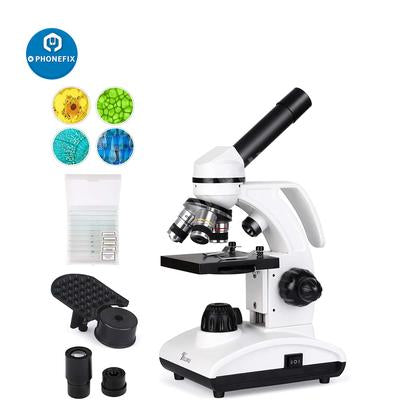Monocular, Binocular, and Trinocular Microscopes Comparison
An important thing to consider when choosing a microscope is its
head type. Monocular, binocular, and trinocular head types are designed
differently and suited for particular types of observations.
Monocular Microscope

Monocular microscopes have a single tube that houses an eyepiece at one end and an objective lens at the other. The design means that specimens will appear flat and without depth when you look in the eyepiece. Monocular microscopes are easy to use and ideal for classrooms or as a home microscope for kids and teens.
Binocular microscopes

Binocular microscopes have two tubes and eyepieces, and this can make it more comfortable to examine specimens. Binocular head pieces can be used in educational, research, and commercial settings.
Trinocular Microscope

Trinocular Microscopes are similar to binocular ones except that they have an extra port for attaching a camera and taking photographs or videos. This makes the trinocular head type ideal for educators or researchers.
Which Microscope is Best for You?
Compound
microscopes tend to require samples that you can pass light through to
create an image, as the light comes from the bottom of the microscope up
through the sample (transmitted illumination).
Stereo microscopes, on the other hand, tend to work best with samples that you cannot pass light through, as they have upper light sources (reflected illumination) to shine down and bounce off of those samples to create an image.
Conversely, if you wanted to view a bacterial cell, you would want to use a compound microscope with a transmitted light, because a reflected light would wash your sample out, as it does not reflect enough light to make an image (as well as because you need the higher magnification to view such small details).
You would probably see a very small outline of the cell, without much detail inside, if any at all, trying to use a stereo microscope with a reflected light with a slide that had a cell sample on it.
Monocular Microscope

Monocular microscopes have a single tube that houses an eyepiece at one end and an objective lens at the other. The design means that specimens will appear flat and without depth when you look in the eyepiece. Monocular microscopes are easy to use and ideal for classrooms or as a home microscope for kids and teens.
Binocular microscopes

Binocular microscopes have two tubes and eyepieces, and this can make it more comfortable to examine specimens. Binocular head pieces can be used in educational, research, and commercial settings.
Trinocular Microscope

Trinocular Microscopes are similar to binocular ones except that they have an extra port for attaching a camera and taking photographs or videos. This makes the trinocular head type ideal for educators or researchers.
Which Microscope is Best for You?
Stereo microscopes, on the other hand, tend to work best with samples that you cannot pass light through, as they have upper light sources (reflected illumination) to shine down and bounce off of those samples to create an image.
Conversely, if you wanted to view a bacterial cell, you would want to use a compound microscope with a transmitted light, because a reflected light would wash your sample out, as it does not reflect enough light to make an image (as well as because you need the higher magnification to view such small details).
You would probably see a very small outline of the cell, without much detail inside, if any at all, trying to use a stereo microscope with a reflected light with a slide that had a cell sample on it.
.jpg)
Comments
Post a Comment